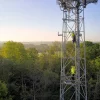New Subsea Cable Link Being Explored for the Shetland Islands

Network operator VodafoneThree UK has today announced that they’ve begun a “feasibility study” to explore the possibility and cost of deploying a new subsea fibre optic cable system to help transform broadband and mobile connectivity in the Shetland Islands – a remote subarctic archipelago that resides some way north of Scotland.
Shetland is currently already connected by two major subsea fibre cables, including the SHEFA-2 (Faroese Telecom) submarine (subsea) and the R100 North cable that was recently built by broadband giant BT as part of the Scottish Government’s £600m Reaching 100% (R100) project (here). The R100 project also deployed a number of smaller subsea fibre links between mainland Shetland and its smaller islands.
Despite this, Vodafone Business has proposed a plan that would involve running a new cable from mainland Scotland to Shetland. But the operator states that such a cable would “provide essential infrastructure for high-speed internet and telecommunications services for local communities, as well as businesses“. This would no doubt also support VodafoneThree’s plan to boost 5G Standalone coverage (here).
Advertisement
We think greater resilience should also be mentioned as one of the above highlights, particularly in today’s climate of rising conflict and security concerns around subsea infrastructure (example).
Richard Lochhead MSP, Minister for Business, said:
“High-speed connectivity is a necessity in today’s world – both for economic growth and everyday life. It is particularly important that residents, businesses and visitors to our rural areas and islands are not left behind in the digital age.
Private investment is critical to delivering this mission and I welcome VodafoneThree’s renewed commitment to help deliver the infrastructure needed to support our island communities, including its intention to undertake a feasibility study into a subsea connection between Shetland and the mainland.”
Nick Gliddon, Director of Vodafone Business, said:
“During our meetings in November 2024, with Shetland Islands Council, it was really apparent to me that connectivity is essential for everything from daily transactions to the growth of businesses and the economy.
Through initiatives like the Shared Rural Network (SRN) programme, we are providing strong and reliable 4G coverage to our customers living in, working in, and visiting Shetland. The proposed cable could transform the connectivity landscape for the islands further, bringing significant economic and social benefits. We remain committed to delivering the necessary infrastructure to ensure the continued prosperity and growth of the islands.”
The timing of all this is quite interesting, not only because of the current climate around subsea security and the fact that it follows so soon after the completion of Vodafone and Three UK’s mega-merger. On top of that, the Scottish Government are also in the process of hunting out a supplier for their £40.7m (state aid) Project Gigabit broadband roll-out scheme for Orkney & Shetland (Lot 6).
The deployment of a new subsea fibre link to Shetland, if approved, would however be an extremely expensive project and it’s difficult to see where the return for VodafoneThree would come from for this without additional support (e.g. state aid or other investors). In 2023 Shetland had just 11,567 domestic properties, as well as 259 hotels / guest houses and 1,655 registered private businesses (most of these are small businesses, but they do now have the SaxaVord Spaceport).
At present this is just a feasibility study and so it remains uncertain whether it will be turned into a serious deployment.
Advertisement
Mark is a professional technology writer, IT consultant and computer engineer from Dorset (England), he also founded ISPreview in 1999 and enjoys analysing the latest telecoms and broadband developments. Find me on X (Twitter), Mastodon, Facebook, BlueSky, Threads.net and Linkedin.
« VodafoneThree Outline Future UK Network Plans and 4G to 5G Speed Boosts





















































It is conceivable that this could also be classified under the defence budget due to the intent to enhance the passive monitoring of the Greenland-Iceland-UK gap.
Shetland is one of Scotland’s main island groupings and therefore an integral part of Scotland not “a remote subarctic archipelago that resides some way north of Scotland” sounds like you’re talking about Jan Mayen or
As with the rest of rural Scotland is regularly underserved by politicians, regulators and network providers based in SE England.
The islands are a key location with regard to defence.